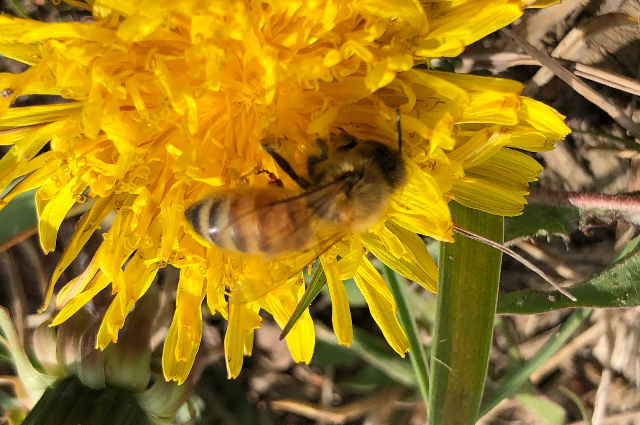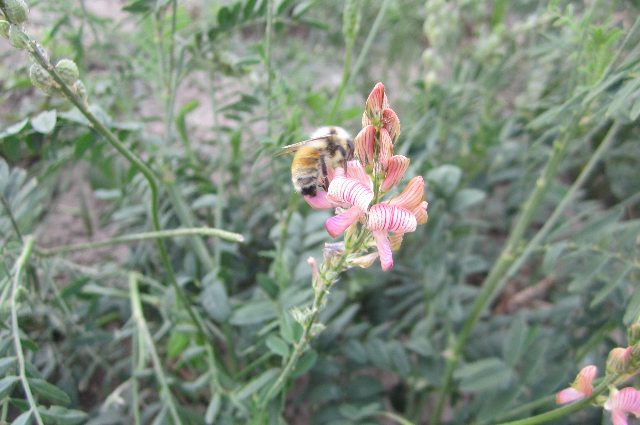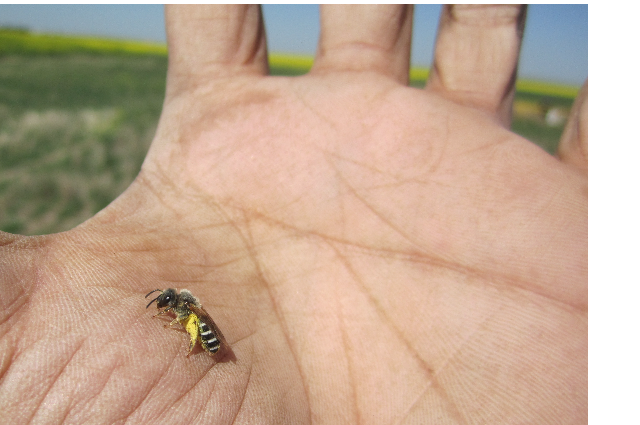Video1: A short video clip showing how the bees collect pollen and nectarines from alfalfa flower in full bloom. © Saikat Kumar Basu
Rahul a twelve year kid has been very upset since last evening once he watched a documentary on Discovery channel that showed how bees around the planet are showing an alarming decline in their numbers due to severe pollution caused by humans! He was amazed to learn that the humble bees are important natural pollinators and are absolutely essential for the survival of our agriculture (crop production) forests and apiculture (honey production). This morning as he joined his grandpa on his morning g walk he looked very sad and restless. Grandpa asked Rahul regarding his sadness and he explained vividly about the loss of bees to the amazement of the seventy year old retired government servant.

Video 2: A short video clip showing how the commercial bee farmers (apiculturists) lay out their bee boxes in strategic places helping honey bees to collect pollen and nectar © Saikat Kumar Basu
Grandpa said to Rahul, ‘I am impressed to note how you have thought about this problem little man...but we need to think about solutions to help the bees rather than being sad Rahul.’ What can we do Grandpa to save the bees ?’, said Rahul. ‘Well first you need to understand the problem clearly and then we need to look for long term solutions my boy.’ Rahul said ‘Please explain it to me Grandpa so that I can understand this better.’ Grandpa sat down on the roadside bench for pedestrians and said, ‘ We as humans are responsible for the decline of bees my lad. We are to blame ourselves first. We have been using so much toxic chemicals such as synthetic fertilizers (chemicals to increase crop production) and pesticides (chemicals killing pests) in our agriculture that it is killing our farmer-friendly insects like bees , spiders , ants , moths and butterflies 🦋, some types of pollination- friendly wasps, beetles and flies in great numbers all over the planet . ‘
Video 3: A short video clip showing how beekeepers take care of their honeybee colonies facilitating collection of pollen and nectar. The adjoining field is a standing crop of black mustard in full bloom © Saikat Kumar Basu

Grandpa continued...’ Rahul you will be amazed to know that over 85 percent of crops and plants that are associated to our lives are dependent on insect pollinators like bees for their reproduction. Not just bees , moths and butterflies 🦋; but hummingbirds, sunbirds, parakeets, bats 🦇 and some other small tree-living (arboreal) mammals are all responsible for helping in pollination of flowers . But bees are the most efficient pollinators and are worst impacted due to pollution, Climate Change and Global Warming, changes in how we use lands, diseases as well as lack of suitable plants for them to collect nectar and pollen. Several species of wasps are reported to be effective pollinators. Furthermore since wasps attack bee colonies as well as predate upon bees; hence they move from flower to flower and also help in pollination. While bees, moths and butterflies can be considered as primary pollinators; some species of wasps, beetles, flies and ants serve as secondary pollinators. All of these move to and fro between flowers ; and thus contribute significantly for the purpose of cross pollination.’

Rahul was amazed to know this and asked again, ‘ Grandpa this is so interesting ; but what exactly is pollination?’ Grandpa laughed and said ‘Well pollination in simple terms is the movement of pollen from one flower to another through air, wind or through animals like bees . This is important for the reproduction in plants and is significant for the balance of our nature and environment. We are dependent on plants for our survival and food. So you can well understand how important is this natural process for our ecosystem as well as our economy as our livelihoods friend on agriculture and the nature is balanced by oxygen released by trees in the . If we lose the bees our future is completely doomed my boy!’
Grandpa looked thoughtful and said with a pause....’One of the sustainable solution for protecting our bee friends is creating sanctuaries for them where they can thrive in peace. Such gardens or sanctuaries are called Pollinator Sanctuaries or Pollinator Gardens where a wide variety of different species of flowering plants suitable for bees and other environment-friendly pollinators could forage for their daily supply of nectarines and pollens...... These sanctuaries could serve as their nesting and breeding sites and together with other pollinator insects , snails and slugs , bird bats 🦇 and small mammal species attracted to luxuriant flowering plants growing throughout the different seasons could truly turn into the ‘Garden of Eden’. I feel that this simple approach could make a significant impact in protecting our dwindling bee and other pollinator populations‘. Grandpa stopped and looked at Rahul’s eye to see his reaction.

Image 4: Without the friendly bees our planet will transform into a barren land devoid of trees and crops ©Saikat Kumar Basu
Rahul seem to be excited about the grand idea about Pollinator Sanctuaries! He asked, ‘Grandpa where could we have these sanctuaries built? Will they be like big forests with lots of trees away from the from human habitations?’ Grandpa laughed and said ‘No my dear, we do not need to think so big and wild . Such Pollinator Sanctuaries could be easily and cheaply built in our home gardens and lawns, backyard kitchens, boulevards, roadside unused spaces, golf courses, along wate rbodies like lakes, swamps, ponds, pools, ditches or canals, on lands not suitable for producing crops or unused spaces or vacant lands in towns and cities as well as in rural areas’. ‘What kind of plants do we need to grow for the bees grandpa ?’ asked Rahul. Grandpa giggled and said, ‘Well my dear these could be very simple plants like roadside ornamentals, garden grown plants , vegetables like radish, crops such as mustard, flax, sunflower , hemp, various legumes like peas, beans, soybean, fennel, coriander, some fruit trees like litchi etc can serve as excellent plants for establishing such Pollinator Gardens or Pollinator Sanctuaries’.
Rahul seems to quite surprised. ‘Well this seems to be a lot of hard work Grandpa, and it will cost us a lot of money!’ said Rahul. Grandpa giggled and said, ‘Oh my great economist not at all! My idea is for locality and weather-specific cheap single season (annual) or multi-season (perennial) crops and plants for growing our Pollinator Sanctuaries.’ Grandpa continued, ....’off course there is some need of money to buy the seeds at the start; but, once the crop or plants are established we need to grow these Sanctuaries as natural mini forests . Labour is needed once to put them on the soil, but after that they will continue to grow from their seeds and vegetative parts year after year on these spots. Who takes care of our forests Rahul? None other than Mother Nature ! In the case of such Pollinator Sanctuaries, nature will take its course in the most organic manner.’

Grandpa continued, ‘I suggest from my experience that we should have a happy balance of trees , shrubs and herbs in the Pollinator Sanctuaries as a natural ecosystem.’ Rahul felt better now as he has learnt a lot about bees and how to protect them. He felt sad as humans we are responsible for destroying our nature. But at the same time he was happy to O’Leary that there are simple steps to save the helpless bees from utter destruction. He realized that as humans we have take responsibility for our own action and works towards building a better, sustainable and environment- friendly society to appreciate and protect our nature. Together we could save our bees and butterflies 🦋 and help Mother Nature to heal and create a better future for us all.
